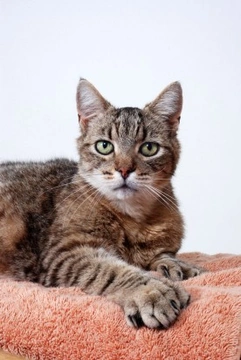
Polydactyl cats - The cats with thumbs!
If the word ‘polydactyl’ is one that you have never heard before, you could easily be forgiven for thinking that it is the name for some kind of dinosaur, or something equally exotic! However, the reality of the matter is somewhat different, although also rather unusual- the word ‘polydactyl’ is taken from the Greek words for many (poly) and fingers (dactyl), and refers to a person, or animal, that has extra fingers, toes or other digits on their hand or foot.Polydactyl cats, therefore, are cats that have an extra toe on one or more of their feet, leading to them sometimes being colloquially referred to as ‘mitten cats’ or ‘boxing cats,’ among many other terms! Often the positioning of the extra toe gives the appearance to the cat of having four fingers and a thumb, in the same way that people do- So, do polydactyl cats really have opposable thumbs? What does it mean to own a polydactyl cat, and is polydactyly (the condition of being polydactyl) a problem for cats? Read on to find out!
What exactly is polydactyly?
Feline polydactyly is a genetically inherited physical anomaly that leads to the cat in question being born with extra toes, usually alongside of the regular toes in the position in which there would, in animals such as people, be a thumb. This ‘thumb,’ however, is not truly opposable, and polydactyl cats are not able to open their own tins or perform any other very un cat-like feats!Normal cats generally have eighteen toes altogether- four on the pads of each paw, and an additional two dewclaws slightly higher up on the front legs. Polydactyl cats generally have just one extra toe per foot and on the front feet only, although additional toes on the rear paws and as many as three additional toes per paw is not unheard of either!
The history and folklore of polydactyl cats
There is a significant amount of folklore surrounding the existence of polydactyl cats, and while historically, polydactyl cats were often feared or reviled as witches’ familiars, the trait of polydactyly is seen in some circles to be a desirable one, and some cats are bred specifically for this trait! Ernest Hemmingway, the famous Nobel-prize winning author, had a particular penchant for polydactyl cats, and consequently ‘Hemmingway cats’ is yet another term often used to refer to them. Polydactyl cats were also historically considered as desirable ship’s cats, which may have its roots in the superior climbing ability and rat catching skills that polydactyl cats often possess.As polydactyly is a genetically inherited trait, certain areas of the world have higher numbers of polydactyl cats than others, as colonies have formed and the mutation has been passed down through the generations. Cardigan in South Wales, areas of the West country and Kingston Upon Hull in the UK all have significant numbers of polydactyl cats comparatively to other regions, although the condition is still very rare in the general cat population in these areas. Similarly, the East coast of America and especially the Boston area is also home to many polydactyl cats as well.Polydactyl cats are generally non-pedigree moggie type cats, although the Maine Coon pure breed also has it’s fair share of multi-digit members, to the extent that many cat-fancier clubs and governing bodies in America recognise the Maine Coon Polydactyl as a breed or sub-breed in its own right.
Is feline polydactyly a problem for the cats in question?
Generally, having extra toes poses no problem to the cat in question at all, and may even give them the edge in climbing and hunting when compared to their eighteen-toed counterparts! Polydactyly is a condition in and of itself, and is not indicative of any other underlying condition, disease or problem.Occasionally polydactyly can pose a problem for the cat, for instance if the additional toes are located in such a way that they are not naturally worn down by walking about or scratching, and so may grow overly long and cause problems if left unchecked. Owners of polydactyl cats generally need to pay a little more attention to their cat’s feet than other owners, and sometimes trim the claws of these extra toes manually to avoid problems.Sometimes, polydactyl kittens have difficulty in the early stages of learning to walk with their additional toes, but this generally resolves itself as the kitten gets older. As mentioned, sometimes the additional digits can even make walking, climbing and other activities easier for the cat, and greatly improve their dexterity!Polydactyly is sometimes confused with other conditions that can appear similar but are actually completely separate conditions, some of which may pose a problem for the cat in question. Feline radial hypoplaisia is one of the conditions that are similar in appearance to polydactyly, but the additional toe(s) in this condition lie flat alongside of the other toes on the pads of the paws, which can lead to problems with walking and can be crippling in later generations. Cats with feline radial hypoplaisia should not be bred from, even if the cat in question manages the condition without a problem- the condition becomes amplified in subsequent generations, and can lead to an untenable quality of life for the affected offspring.
Getting a polydactyl cat
Polydactyl cats are generally in some demand, as the condition is unusual and generally, poses no problems for the cat in question. As the condition is hereditary, polydactyl cats will produce other polydactyl cats if bred, and breeders and owners will advertise this fact when seeking to sell or re-home the subsequent kittens. If you fancy the idea of owning a polydactyl cat, keep an eye on the classifieds section here on Pets4Homes, and make sure that you view and examine any polydactyl kitten that you might be considering buying carefully, to ensure that the cat or kitten is a true polydactyl, and not suffering from feline radial hypoplaisia instead.



